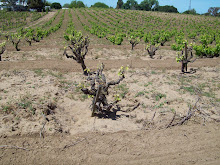
Yeah, the figure skater gets clipped, but still goes on to win a medal. The Carignane grape gets clipped, and it gets thrown into a vat for blending.
Oakley is home to 100-plus-year-old plantings of Rhone varietal vines, and you would not believe the number of old-skool farmers who pronounce “care-een-yawn” as “care-again.” Not a big deal; I know what they mean, and I’ve heard just as many misspeakings in Napa tasting rooms (“Rye-zling,” “Vee-oh-yay,” “Mare-it-TAJ.”) Hey, it’s all good. We’re talking about a beverage here, and when said bev comes from grapes grown from these century-old gnarly vines, call it what you want; just don’t call me too late for tasting.
Kath and I have tasted varietally bottled Carignane; it’s cool as an experiment, but the real deal is what this grape brings to the party in mixed company. Like some people at a mixer, Carignane can be acidic; it can be colorful. And by itself, it can be downright lonely.
When the old Iberians brought the cuttings over from the old country to the Delta here, who would have thought that the folks who wanted Zin, Mataro, Cinsault, and … yes … Kerrigan, would ever have thought of a Bizarro-world Universe wherein this prolific grape keeps giving the love? Over the last several months, we’ve tasted a lot of CoCo juice; “Kerrigan” has been a key component in a lot of it.
Not that grammar or pronunciation was ever the deal with this grape. No matter how one pronounces “Carignane” – and whether you decide to ditch or keep the extra “e” when writing about it – around Oakley, the vines are old, they’ve taken hold, and their story should be told.
A while back, Eric Asimov of The New York Times quoted winemaker Joel Peterson of Ravenswood Cellars, talking about Carignane vines: “All you have to do is plant them in the right soil, in the right climate with good exposure to the sun, keep the yields down, and then wait 80 years for the vines to become old.”
Yep, cultivation of Kerrigan is a walk in the park.
Speaking of walking, Kathy and I have seemingly meandered full circle with this blog, the genesis of which was the wonderment we first experienced 10 months ago when we realized that wines we had been drinking for decades have been made from century-plus-old vines in our newly adopted city in Northern Cali’s far East Bay. You can’t throw a cork (or preferably, a screw cap) around Oakley without it landing in an old-skool grove of 19th-century Mourvèdre, Zinfandel, Petite Sirah or, yes, Kerrigan.
Kath was reminded of our fascinating CoCo oenological education when she happened, while driving home from work this week, to see workers out in the vineyards pruning the vines in an effort to shear them of new shoots and canes, in anticipation of bud break and yet another crush several months hence. Nice to see that these superannuated vines are alive and well and still producing, even if they do need a little bit of assisted living in-patient care once a year. Circle of life indeed.
Our pal Randall Grahm, he of the “I love you! I hate you! You’re perfect! You’re nuts!” relationship with our ‘hood gives today’s post a bissel closure with his 2008 Bonny Doon “Cunning,” an old-vine Contra Costa blend of 61% Carignane and the rest, Mourvèdre. As the name suggests, it’s a sly little beast of a bottle: It’s got the bright cherry red color of a young Beaujolais, with the fresh Gamay brightness of cherry fruit continuing on the nose. On the tongue, it’s very nimble, with nice acidity dancing around before sitting one out with a refreshingly light finish. The 2008 Cunning is a nicely stylish quaff, this fox.
Also, props and thanks to the folks at Cline. I mentioned last time about our corked bottle of 2007 Heritage Zinfandel. I gave them a call this week, and they were so apologetic, they offered to ship out a bottle of the 2008 (the 2007 is long gone) at no charge. It arrived yesterday. Class act.




